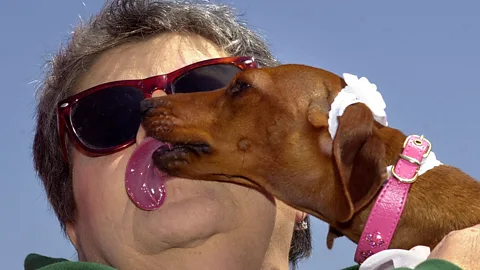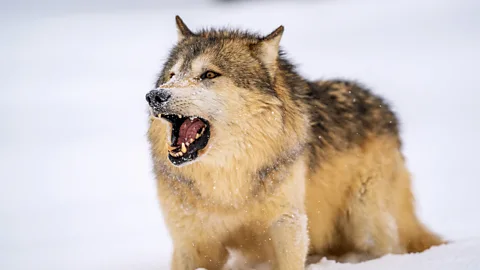The hidden history behind our pets' most revolting habits
 Getty Images
Getty ImagesFrom pooing in strangers' gardens to barking incessantly, even the most precious pets can be annoying, embarrassing, or just plain revolting. Where did these behaviours come from?
In a leafy suburban corner of south-east London, a war is brewing.
It started in May this year, when one of my neighbours took a sudden interest in the little wilderness at the front of his house. Over the next three weeks, he could regularly be seen labouring away, hacking out weeds, smoothing the soil, and adding compost. Then one day, it was time to add the finishing touch – a soft carpet of pristine turf. The result was as neat and carefully manicured as the green slopes around Windsor Castle. I wondering what the local cats would make of it.
The first night brought a swift, decisive answer. Once as flat as a snooker table, the next day the lawn's surface was ridged and twisted, as though the turf rolls were tectonic plates that had been pushed against each other. It was scattered with little brown curls of cat poo.
Undeterred, my neighbour put the garden back together and stayed up every night for a week, to ward off any more marauding felines. But it happened again – and again, and again. As I type, his fortifications have escalated to almost ludicrous proportions. The lawn's entire surface is now sheathed in protective netting, and there are little pots of vinegar at each corner, which cats supposedly detest. The final insurance is an ultrasonic cat scarer, which blasts out unpleasant sounds in a range that they're particularly sensitive to. So far, the defences are holding up – but who knows how this battle could end. (I might suggest a moat.)
As it happens, gangs of defecating cats look set to become a lot more common. In the UK, the most fashionable pets are now collectively almost a third as populous as humans, with an estimated 10.1 million dogs, 10.9 million cats and one million rabbits. Likewise, worldwide pet ownership is booming – in Japan, businesses have embraced the new trend by launching dog clothing lines and cat hotels, leading some commentators to suggest they're replacing children. In the US, there are almost 78 million dogs and 58 million cats.
 Alamy
AlamyBut as more and more pets have bounded into our homes and slunk onto our laps, some of these precious new family ' less desirable habits have become more apparent. There's the incessant barking and meowing that can keep whole neighbourhoods awake, digging up of plants, jumping up with scratchy claws, chewing of wires, and – apologies for so many nauseating poo references – enthusiastic consumption of other animals' faeces.
(The latter is regrettably normal. One dog in my acquaintance, an elegant chocolate-brown greyhound called Buddy, races into his garden each morning to snaffle up any delicacies left for him the night before by the local foxes. If his guardian turns her back for a second while they're out walking, he'll locate and ingest several reeking deposits. At BBC Future we feel that this tantalisingly disgusting fact deserves its own piece, so we'll cover this one in more detail later in this series.)
Where did companion animals – whose behaviour is often so carefully aligned with human preferences that dogs have evolved a dedicated muscle in their eyes to make them cuter, and cats have learned to interpret our facial movements – get those habits that are annoying, disturbing, or just plain revolting? And how can we learn to live with them?
To trace the origins of any particular behaviour, there are two important factors to consider – the wild animal your pet evolved from, and its history of living with humans.
Jumping up
The closest living relative of dogs (Canis familiaris) is the grey wolf (Canis lupus), which is native to Eurasia and North America. However, it's thought that dogs are not their direct descendants – one genetic analysis revealed that modern dogs are equally closely related to wolf populations from several different parts of the world, suggesting that they all evolved from a common ancestor instead.
This mysterious, now-extinct wolf species might have lived in Siberia approximately 23,000 years ago, and been thrown together with small, isolated groups of hunter-gatherers by the frigid conditions of the last ice age, when much of North America, Northern Europe, and Asia was frozen over.
 Getty Images
Getty ImagesAt first, perhaps the wolves merely followed humans around, snapping up discarded scraps of food as they moved from camp to camp – or they may have hunted in packs alongside humans, chasing down large prey and providing such an advantage that they allowed us to out-compete our close relatives, the Neanderthals. Another possibility is that it all began with ancient humans keeping wolf pups as pets.
Eventually the relationship deepened and the wolves underwent a physical transformation – their ears became floppy, their tails curved, and their coats became mottled. (An eccentric 62-year experiment in Russia, in which foxes were selectively bred until they had no fear of humans, has revealed that these are common side-effects of evolving tameness.) They also adapted their behaviours to suit their new collaborators – in some cases, exaggerating traits already found in their wild ancestors, and in others, inventing brand new ones. To find out which is which, all you have to do is compare dogs with modern-day wolves.
You might also like:
Take the excitable greetings of many dogs, who jump up and try to lick your face, eventually settling for whichever part of the body doesn't recoil quickly enough. "They would like to give a 'kiss' – or at least this is how people describe it," says Zsofia Viranyi, an expert in comparative cognition at the University of Veterinary Medicine, Vienna, and co-founder and co-director of the Wolf Science Centre.
In fact, this trait – often ranked high among dogs' most annoying habits – is a quintessential wolf behaviour – a relic from their ancestors tens of thousands of years ago.
As pups, wolves routinely jump up and lick inside other pack ' mouths after they have returned from a hunt, as a way of begging for food. Just like penguins in the Antarctic, the adult wolves will promptly vomit up a half-digested meal for them to eat.
"And then the older animals also keep the behaviour and they use it for greeting basically," says Viranyi, who explains that it generally involves lower-ranking individuals licking the mouths of those with higher status. "So basically, whenever the pack comes together, and they want to do something together, or when somebody was away and then returned," says Viranyi.
If you let them, wolves will also do this with humans. "Some people who raise wolves will actually kiss them," says David Mech, a senior research scientist with the US Geological Survey who has studied wolves for decades. "I knew one guy that basically French kissed his wolf." Thankfully dogs seem to have dialled it down a bit.
 Alamy
AlamyBarking and meowing
On the other hand, some habits that are perfectly normal in the wild ancestors of our pets have been greatly exaggerated.
Like dogs, cats have also been living with humans for millennia. They're descended from North African/South-west Asian wildcats (Felis silvestris lybica) – solitary, territorial animals that primarily feed on small rodents. Genetic and archaeological evidence suggests that they may have originally encountered humans in the famous Fertile Crescent region of the Middle East at least 6,500 years ago, where the first farming communities sprung up. (Other than domesticating cats and pioneering farming, the people in these settlements also invented the earliest writing systems and the wheel.)
Initially, the cats hung around for the banquet of rodents that thrived around human settlements, but eventually they began to interact more and more with people – and ended up as unlikely candidates for domestication. They dispersed from their homeland along human trade routes, first spreading to Europe and Africa, where they made their way into ancient Egyptian religions – the goddess Bastet was often depicted as a cat – pyramids and hieroglyphs, and interbred with local North African wildcats.
Which brings us to a trait that some cat owners might consider an inherent part of their appeal – while others feel compelled to desperately search "how do you get a cat to shut up">window._taboola = window._taboola || []; _taboola.push({ mode: 'alternating-thumbnails-a', container: 'taboola-below-article', placement: 'Below Article', target_type: 'mix' });
